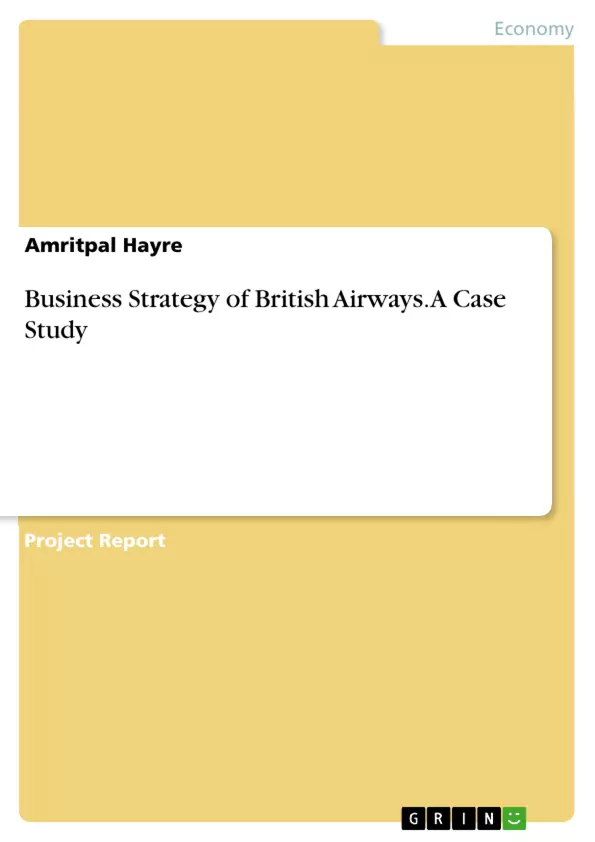This report discusses British Airways in a strategic context whilst producing organisational and environmental audits on the case study. Furthermore it identifies the stakeholders and suggests a business strategy for the organisation. Finally timescales are proposed to achieve and monitor the strategy for the context of British Airways whilst identifying the resource requirements. This report is part of the BTEC Higher National Diploma series by the author and relates to Unit 7 - Business Strategy.
Table of Contents
- 1. Introduction
- 2. Strategic Context
- 3. Strategic Planning Issues
- 4. Planning Techniques
- 5. Organisational Audit
- 6. Environmental Audit
- 7. Stakeholders
- 8. Alternative Strategies
- 9. Horizontal Integration
- 10. Resource Requirements
- 11. Targets and Timescales
Objectives and Key Themes
This case study analyzes British Airways' strategic position, planning issues, and potential strategies. The aim is to provide a comprehensive overview of the company's strategic context, identifying key challenges and opportunities within the aviation industry.
- Strategic analysis of British Airways
- Evaluation of strategic planning issues impacting BA
- Exploration of suitable planning techniques for BA's context
- Identification of key stakeholders and their influence
- Assessment of potential strategic options
Chapter Summaries
1. Introduction: This introductory chapter sets the stage for the case study by outlining its scope and objectives. It clearly states the intention to analyze British Airways within a strategic framework, conducting organizational and environmental audits, identifying stakeholders, selecting a suitable business strategy, and proposing timescales and resource requirements for implementation and monitoring.
2. Strategic Context: This chapter establishes the strategic context of British Airways, examining its vision statement ("become the World's most responsible Airline"), philosophy ("to be the world's global premium airline"), and goals ("be the airline of choice for long-haul premium customers" and "meet customers' needs and improve margins through new revenue streams"). It also identifies BA's core competencies: providing premium quality service and offering flights to major global cities, highlighting its significant market share in the UK.
3. Strategic Planning Issues: This chapter delves into several key strategic planning issues that may impact British Airways. The first issue revolves around internal resources, such as the potential need to find alternative jet suppliers if existing ones cannot meet the company's needs. The second issue concerns the individuals involved in strategic planning, particularly the importance of selecting the right departments and personnel for implementing new strategies. The third addresses the volatile external environment and its impact on market research and pricing decisions.
4. Planning Techniques: This chapter explores planning techniques applicable to British Airways' strategic planning process. It analyzes the BCG Growth-Share Matrix, positioning BA as a "Cash Cow" in the UK aviation market, suggesting a "hold" strategy due to its dominant market share and minimal growth rate. The chapter then introduces the Strategic Position and Action Evaluation (SPACE) matrix, suggesting an "aggressive" strategy for BA given its financial strength and competitive advantage, recommending initiatives like buying out competitors to further consolidate market dominance.
Keywords
British Airways, strategic planning, strategic analysis, SWOT analysis, BCG matrix, SPACE matrix, stakeholder analysis, competitive advantage, market share, resource allocation, airline industry, premium service, long-haul flights.
British Airways Strategic Analysis: FAQ
What is the purpose of this case study?
This case study provides a comprehensive analysis of British Airways' strategic position, planning challenges, and potential future strategies. It aims to offer a detailed overview of the company's strategic context, highlighting key opportunities and obstacles within the competitive aviation industry.
What topics are covered in the case study?
The case study covers a wide range of topics, including British Airways' strategic context, strategic planning issues, suitable planning techniques, key stakeholder identification and influence, and an assessment of potential strategic options. It also includes an organizational and environmental audit.
What are British Airways' stated vision, philosophy, and goals?
British Airways' vision is to "become the World's most responsible Airline." Its philosophy is "to be the world's global premium airline," and its goals include "being the airline of choice for long-haul premium customers" and "meeting customers' needs and improving margins through new revenue streams."
What are British Airways' core competencies?
British Airways' core competencies are providing premium quality service and offering flights to major global cities. Its significant market share in the UK is also a key strength.
What strategic planning issues are discussed in the case study?
The case study identifies several key strategic planning issues: securing alternative jet suppliers if needed, selecting the right personnel for strategic implementation, and navigating the volatile external environment's impact on market research and pricing.
What planning techniques are analyzed in the context of British Airways?
The case study analyzes the BCG Growth-Share Matrix, categorizing BA as a "Cash Cow" in the UK market, suggesting a "hold" strategy. It also examines the Strategic Position and Action Evaluation (SPACE) matrix, suggesting an "aggressive" strategy, recommending actions like acquiring competitors to enhance market dominance.
What are the key stakeholders influencing British Airways?
While the specific stakeholders aren't explicitly listed, the case study emphasizes the importance of identifying and considering the influence of various stakeholders in the strategic decision-making process.
What are the potential strategic options for British Airways?
The case study suggests an "aggressive" strategy based on the SPACE matrix, which could include actions like mergers and acquisitions to further solidify market leadership.
What is the structure of the case study?
The case study is structured with an introduction, chapters on the strategic context, strategic planning issues, planning techniques, and a conclusion outlining resource requirements and timescales. It also includes chapter summaries and a list of keywords.
What are the key words associated with this case study?
Key words include: British Airways, strategic planning, strategic analysis, SWOT analysis, BCG matrix, SPACE matrix, stakeholder analysis, competitive advantage, market share, resource allocation, airline industry, premium service, and long-haul flights.
- Citar trabajo
- Amritpal Hayre (Autor), 2014, Business Strategy of British Airways. A Case Study, Múnich, GRIN Verlag, https://www.grin.com/document/287089



